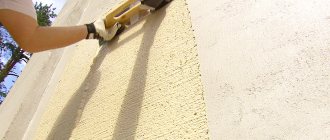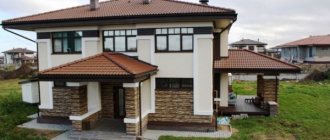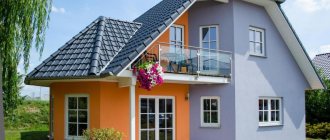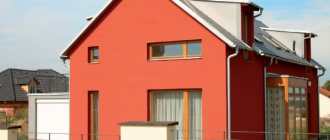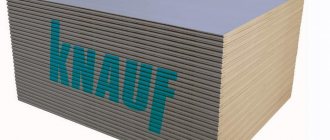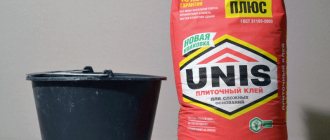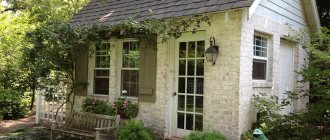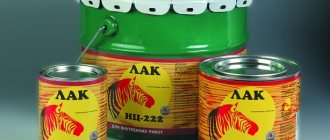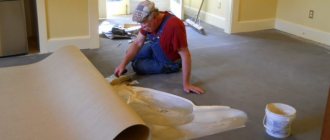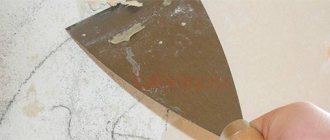The external decoration of the walls of a building is as important and responsible a stage as the installation of window and door units, laying insulation, and installation of electrical wiring.
The better the facade of the building is finished, the more beautiful its appearance will be and the better it will be protected from the effects of various negative factors: rain, snow, wind.
The most important principle of external wall finishing is to provide a reliable frame made of finishing material, which at the same time will allow the walls to “breathe”.
It is for this reason that it is necessary to approach the selection of a suitable material, namely plaster, as responsibly as possible.
Only high-quality finishing will extend the life of the building and make it as attractive as possible.
Description of frost-resistant facade plaster
The most economical, simple and affordable finishing option is a dry mixture for plastering walls. You can buy it in any store at a low price. Preparing the mixture for use is also not difficult - just dilute the mixture with water in a convenient container and stir thoroughly.
The most famous brands of such compositions are: “Knauf”, “Moment”, “Ceresit”, “Vetonit”. The packaging used is standard - paper bags of 25-30 kilograms. The cost of different brands of goods in different regions differs, however, on average, the mixture is not very expensive.
At the same time, not all dry compounds can successfully withstand frost and moisture in order to sufficiently protect the building facade from external, negative factors, so other, special compounds are used.
It is these companies that produce special frost-resistant and moisture-resistant putties. The compositions are available ready-made, have a paste consistency and dry very quickly.
NOTE!
The main advantage of this putty is that the composition practically does not shrink or crack . The main disadvantage of this finishing is its high cost in comparison with plaster mixtures.
Putties are used to finish an already prepared facade, since the thickness of the coating should not exceed 5 mm. In addition, the walls must be covered with special mixtures and plaster. This will ensure a smooth surface and maximum adhesion to the putty.
Frost-resistant (winter) mixture is also called finishing , as it is used for final finishing of the outer surface of the walls of various structures and buildings.
Expert advice
In order for the owner to experience as few unpleasant situations as possible in the process of finishing external walls and avoid making serious mistakes, one should turn to the experience of professional builders who, as part of their duties, often deal with frost-resistant plasters TIM 26 and other compounds.
First of all, you need to take into account that when preparing the external base for work, you cannot use water , a wet base under the influence of low temperature will quickly become covered with ice, which will make further work impossible. It is also not recommended to dilute the mixture with water, due to the same danger of the liquid freezing due to cold.
Working in the cold is characterized by various difficulties and troubles; it is recommended to prepare warm gloves in advance , since it will be almost impossible to carry out installation with standard rubber ones. Among other things, you should not dilute a large amount of the mixture at once; at low temperatures, TIM 26 or another frost-resistant mixture can quickly lose its performance characteristics.
Specifications
The use of frost-resistant plaster is especially important in regions where very low temperatures prevail in the winter and very high temperatures in the summer months.
As a result of such negative influence, the surface of any building and structure experiences additional load.
A particularly difficult situation can arise when the facade covering has a high level of moisture absorption, as a result of which the absorbed water, freezing, increases in volume and tears the finish.
Naturally, the building in this case loses its original appearance and requires mandatory repairs.
IMPORTANT!
Therefore, in order to ensure the safety of the structure and ensure a long service life, finishing materials should be used that will have the necessary technical characteristics.
Frost-resistant putty is an ideal solution in this case, since it has properties that fully satisfy the future operating conditions of the building.
Let's consider all these properties in more detail, for which we will make a small table:
| Property | Description |
| Absorbs moisture in minimal amounts | The composition easily prevents mechanical destruction of the building, also prevents the formation of mold and increases the heat-saving characteristics of the overall structure. It should be noted that when moisture is absorbed, many materials lose their qualities as a heat-insulating material, therefore, insulation materials cannot cope with this problem; in this regard, it is necessary to use putty that does not absorb moisture. |
| Excellent resistance to low temperatures and does not burst in the cold | The material fully retains its properties even when frozen and after defrosting, regardless of what temperature conditions are observed. It is important that qualities can be maintained over many cycles. |
| Good steam permeability | An important point to consider when finishing is that the materials (wood, brick or aerated concrete blocks) must “breathe”. If the base of the building is made of these materials, then it is necessary to ensure a complete escape of water vapor and the house to the outside. If this does not happen, then moisture will accumulate under the putty and as a result mold will form, the wood will begin to rot and the structure will quickly become unusable. |
| Not susceptible to mechanical stress | After the putty has hardened, it should acquire a new quality that will allow it to successfully withstand various mechanical influences - scratches, impacts, and other damage. |
| Environmentally friendly mixture | This characteristic is especially important for materials that are used for interior decoration, however, when performing exterior decoration, environmental safety is also an important parameter. It is better to carry out finishing using environmentally friendly compounds that are not capable of causing harm to the human body either during finishing or after its completion, during the operation of the house. |
In addition to these characteristics, indicators such as elasticity and ease of application of the material . When choosing putty, you need to take into account the type of binder, its cost and manufacturer. It is best to purchase finishing from trusted companies, as this guarantees high quality of the finished product.
Briefly about the main thing
Warm plaster is a mixture for rough leveling walls, which has a low thermal conductivity coefficient.
The material has thermal insulating properties due to additional filler in addition to sand.
Traditional cement and gypsum are used as a binder; clay and slaked lime may be contained.
The functional filler can be organic (polystyrene granules), mineral (perlite, vermiculite, pumice, expanded clay chips) or sawdust (sawdust with paper).
In terms of thermal insulation properties, an effective layer of warm plaster of 50 mm is comparable to walls of 2 bricks or slab polystyrene foam with a thickness of 20-40 mm.
The process of plastering walls, ceilings and facades is carried out using the same technology that applies to other leveling analogues.
Ratings 0
Types of frost-resistant facade plaster
Frost-resistant putty can be of several types and types. First, let's look at the types of frost-resistant compounds that are used to decorate the walls of buildings.
The following types are distinguished:
- dry or powdered finishing putty, which allows you to obtain a solution of the required consistency and has an affordable price. To prepare the finished mixture, you should use the instructions;
- ready-made liquid mixture , which can be sold in cans, bottles, buckets, depending on which company produces it. As a rule, such compositions can be stored unopened for a very long time and only need to be stirred before use. Liquid formulations are expensive.
In addition to the types, there are certain types of ready-made putties:
- Latex. This type of finishing material is quite common and popular, however, it is often used for finishing drywall . The material is very economical in consumption, has a pleasant consistency, very elastic and durable. After application, it dries quickly and prevents cracks from forming.
- Adhesive . The second name for this composition is an oil-glue mixture. This composition was the first to appear on the finishing materials market and remains relevant to this day. The mixture is very dense and even with a small layer of application creates a heavy and durable coating . On the other hand, this is also a disadvantage, since applying vertical layers is quite difficult. The putty is well suited for filling floors and has a high level of water resistance.
- Acrylic. Plaster, which is an ideal solution for finishing the facade . The fact is that it is applied in a very thin layer, but this makes it possible to level the surface of the walls as much as possible. The putty can be bright white and is moisture resistant. With its help, puttying is quite easy. It is these characteristics that explain the popularity of this composition.
- PVA - putty . This mixture is based on PVA glue. Basically, the material is used for areas prone to the formation of fungus, mold, and rot . The disadvantage of the mixture is its strong odor, which evaporates over time.
When choosing the type of putty, it is necessary to take into account all the characteristics and important indicators that will become decisive in the future. Only high-quality frost-resistant putty will protect the facade of the building from the negative effects of the environment.
The dangers of non-compliance with the temperature regime
In order to extend the life of the building façade, it is necessary to observe not only the ambient temperature, but also the technology for applying plaster. If the instructions for the mixture indicate a certain temperature regime, it should be adhered to. Although the additives in the mixture are frost-resistant, they can only work at certain temperatures. If this range is not maintained, the moisture inside may begin to freeze, and the polymerization process will occur unevenly or even stop for a while, and the plaster will not be able to gain the required strength. After thawing, it will move away from the surface or become cracked as it dries.
Coating technology
There is a certain procedure for applying frost-resistant putty to the wall. As we have already noted, the walls must be pre-prepared, leveled and finished with additional compounds.
NOTE!
It is important to remember that frost-resistant putties should be applied only at above-zero temperatures.
If you neglect this condition, the coating will turn out to be of poor quality and will very quickly require repairs.
In general, wall finishing work is carried out in stages. The following stages of work can be distinguished:
- the necessary measurements are taken in order to calculate the volume of finishing material. To do this, you will need to calculate the coverage area and multiply by the approximate consumption indicated in the instructions;
- check the walls, if necessary, tighten them with reinforcing stack, plaster, if there are chips and cracks, remove all existing chips;
- before puttying, treat with a primer;
- start puttying.
Do not forget that frost-resistant putty is prepared strictly according to the attached instructions. If you violate the recommendations, this will lead to a deterioration in the technical characteristics of the composition and will significantly complicate the intended work.
First, you need to apply the starting layer using a metal float or spatula . It is important to distribute the mixture evenly, without skipping sections and gradually leveling the surface of the wall.
After the first layer has dried, you can begin finishing puttying. The material should be applied very efficiently, gradually bringing it to an ideal state. After the coating has dried, you will need to sand the walls using a mesh or sandpaper . The finished coating is primed and covered with facade paint.
Consumption of plaster mixtures
Experienced builders definitely pay attention to this parameter. After all, the amount of material purchased depends on it.
On the packaging, manufacturers must indicate the material consumption in the form of a fork of two numbers. The spread is sometimes quite large. This depends on the quality of the finished base, its evenness, and the fraction of fillers.
- Mineral – 2.5-4 kg/m².
- Acrylic – 1.5-3 kg/m².
- Silicone - 2.5-3 kg/m².
The manufacturer must indicate the material consumption on the packaging Source stroimdom.com.ua
Peculiarities
Facade plaster is intended for external use and must meet the following requirements:
- good vapor permeability indicators (otherwise the greenhouse effect between the layer of material and the walls of the building cannot be avoided, which means the destruction of the latter, the appearance of mold spots outside and inside the building);
- resistance to negative natural factors and temperature changes;
- resistance to mechanical and static load;
- ease of application.
The mixture can have a different composition, which greatly affects its technical characteristics, in particular, the durability of the coating. On average, repairs will be required after 7-10 years for cheaper mix options and after 15-20 years for premium materials.
The material has such advantages as environmental friendliness, fire safety, the ability to obtain a variety of aesthetic effects, light weight, moisture resistance and vapor permeability. However, if we compare its strength with the strength of ceramic or facing tiles and a number of other materials for home decoration, then plaster is significantly inferior to them. That is why plaster is actively used to decorate a private home and, a little less often, public institutions.
7 photos
Consumption of working mixture for facades, how to estimate
Before starting external work, it is necessary to determine how the working mixture will be consumed. On average, plastering one square meter will require 2-4 kilograms of mixture. To more accurately determine the solution consumption, two factors are taken into account:
- Type of solution used. For plastering facades, silicone, mineral and acrylic mixtures with different consumption rates are used. Manufacturers of such formulations indicate on the packaging information about the costs of each of them.
- The material from which the wall is made. Most of the mortar is consumed when working with brick walls. This surface is the most prominent due to the gaps between the bricks and therefore more working mixture will be needed to plaster it.
What materials and tools are needed
In order to carry out finishing plaster, you will need the following tools:
- A special container in which the composition will be diluted;
- The spatula is narrow and wide (the first is to collect the mixture from the container, and the second is to directly lay it);
- Trowel or ladle;
- Construction float;
- The rule is to level the surface and correct minor defects;
- Special corner for processing hard-to-reach surfaces;
- Paint brush for working in confined spaces.
The effectiveness of the work performed largely depends on the type of finishing plaster chosen. The best option for walls not in a building is a cement-based composition. But it’s quite difficult to prepare one yourself, since you need to maintain proportions.
Polymers are added to the mixture to improve adhesion and plasticity. If there are high levels of moisture outside, it is recommended to use cement and sand plaster. It is preferable to treat wooden surfaces with gypsum or clay plaster. This is explained by the property of the composition - it prevents fire.
